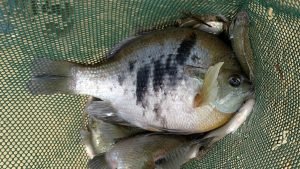Hand-painted photo
Bluegill, just like any other fish, grow slower in a hatchery setting than they would at a lower density. For example, in a pond properly managed for trophy bluegill, the number of bluegill larger than one inch per acre will be measured in the hundreds, whereas in a hatchery pond there will be tens of thousands. All those extra mouths translate to exponentially more competition for food, and much slower growth.Here's the clearest, simplest way I can show you the difference between my company and any of my competitors: there's an article that was recently published about a pond management company much larger than mine (for the moment); the article was touting the job said company had done on re-stocking a 7.5-acre lake from scratch. The article bragged how the three-year-old bluegill in the lake (two years after initial stocking) were up to nine inches in length, as though this were a great management success.The fish pictured below was seined yesterday from a 3/4-acre pond in which we raise hand-painted bluegill. We seined dozens of these fish that were between nine and ten inches in length, and hundreds more that were over eight inches. All of these fish are less than two years old because the pond didn't have its first hatch until late May 2015; it didn't hold water before October 2014, which is when the brood stock were initially stocked (fifty fish). Between fall of 2015 and now this pond has never had less than 15,000 bluegill in it; most of those fish, of course, at any given moment are between a half-inch and two inches in length, but for reference, only 1,000 fingerling bluegill per acre were stocked in the aforementioned lake about which the article was written. If you like style more than substance, hire our competitors. If you want bigger fish, hire us.
If you like style more than substance, hire our competitors. If you want bigger fish, hire us.
